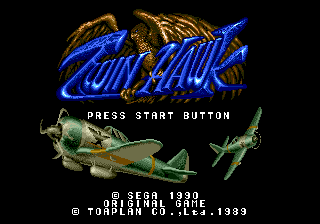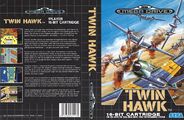Difference between revisions of "Twin Hawk"
From Sega Retro
| Line 62: | Line 62: | ||
==Physical scans== | ==Physical scans== | ||
| − | {{ratings | + | {{ratings|MD}} |
| − | | | ||
| − | |||
| − | |||
| − | |||
| − | |||
| − | |||
| − | |||
| − | |||
| − | |||
| − | |||
| − | |||
| − | |||
| − | |||
| − | |||
| − | |||
| − | |||
| − | |||
| − | |||
| − | |||
| − | |||
| − | |||
| − | |||
| − | |||
| − | |||
| − | |||
| − | |||
| − | |||
| − | |||
| − | |||
| − | |||
| − | |||
| − | |||
| − | |||
| − | |||
| − | |||
| − | |||
| − | |||
| − | }} | ||
{{Scanbox | {{Scanbox | ||
| console=Mega Drive | | console=Mega Drive | ||
Revision as of 17:30, 1 May 2021
- "Flying Shark" and "1943" redirect here; some magazine reviews mislabel this game as such, though Twin Hawk does bear a resemblance to the former. Aside from that, though Flying Shark was never ported to a Sega system, that game's sequel, Fire Shark, was.
| ||||||||||||||||||||
| Twin Hawk | ||||||||||||||||||||
|---|---|---|---|---|---|---|---|---|---|---|---|---|---|---|---|---|---|---|---|---|
| System(s): Sega Mega Drive | ||||||||||||||||||||
| Publisher: Sega | ||||||||||||||||||||
| Developer: Toaplan | ||||||||||||||||||||
| Original system(s): Arcade boards | ||||||||||||||||||||
| Genre: Shooting[1][2] | ||||||||||||||||||||
| Number of players: 1 | ||||||||||||||||||||
| ||||||||||||||||||||
|
This teeny-tiny article needs some work. You can help us by expanding it.
Twin Hawk, originally released in Japan as Daisenpu (大旋風), is a 1989 arcade shoot-'em-up by Toaplan. It was ported to the Mega Drive by Sega in 1990, and released exclusively in Japan and Europe.
Contents
Gameplay
Twin Hawk is one of Toaplan's most straightforward games, unusual to see so late especially after the likes of Truxton. Despite this, Twin Hawk has a number of interesting traits that not many games do: there are absolutely no breaks and the entire game is essentially one giant level, and there are only land and sea enemies to be fought, among other things. The most major of these is the ability to call in a formation of six white "Helper" planes similar to your own, that shoot with you and even divebomb the nearest enemy when each is shot. Unfortunately, when used correctly, these can completely trivialize the game...
![]() and
and ![]() shoot, and basic rapidfire is available in the options.
shoot, and basic rapidfire is available in the options. ![]() summons the "Helper" planes; pressing pressing
summons the "Helper" planes; pressing pressing ![]() again before the formation completes (when they'll start shooting) will trade the Helpers for a typical "bomb" attack like other Toaplan titles, while pressing
again before the formation completes (when they'll start shooting) will trade the Helpers for a typical "bomb" attack like other Toaplan titles, while pressing ![]() at any point after the formation is completed will force all remaining Helpers to divebomb.
at any point after the formation is completed will force all remaining Helpers to divebomb.
There are three different types of powerups, released by destroying specific non-hostile trucks (land) and boats (sea), painted in various colors to show with powerup they release:
- Green trucks and boats do not drop anything, though they give you points for destroying them. All trucks/boats start off as green and change color depending on certain conditions. For example, if you have no powerups (such as after dying), certain trucks/boats will be orange.
- Orange trucks and boats release orange S icons, which upgrade your regular shot. This can be upgraded three times (four sets of two bullets), after which all scheduled orange trucks/boats will be green.
- White trucks and boats release white H icons, which add another Helper to the Helper stock. They seemingly never appear when you have two Helpers stocked, and appear frequently when you have none.
- Blue trucks and boats release blue plane icons, which add an extra life to the life stock. These are extremely rare, likely triggered with lower life stocks.
While Twin Hawk is more or less one giant stage with numerous boss-like enemies, the game is functionally divided into four large areas, punctuated by a change in music (and specifically marked in ports). There is a particularly large tank as the final boss, after which the game begins again at a higher difficulty, etc.
Versions
Like many of the Mega Drive Toaplan ports, a single cart with multiple regional versions was made for all releases of the game, and these can be switched between simply by playing the cart on a particular regional model or by using Game Genie and the like. Attempting to play the cart on an American Genesis triggers the slightly easier "Twin Hawk" version.
Localised names
| Language | Localised Name | English Translation |
|---|---|---|
| English | Twin Hawk | Twin Hawk |
| Japanese | 大旋風 | Daisenpu |
Magazine articles
- Main article: Twin Hawk/Magazine articles.
Promotional material
Physical scans
| Sega Retro Average | ||||||||||||||||||||||||||||||||||||||||||||||||||||||||||||||||||||||||||||||||||||||||||||||||||||||||||||||||||||||||||||||||||||||||||||||||
|---|---|---|---|---|---|---|---|---|---|---|---|---|---|---|---|---|---|---|---|---|---|---|---|---|---|---|---|---|---|---|---|---|---|---|---|---|---|---|---|---|---|---|---|---|---|---|---|---|---|---|---|---|---|---|---|---|---|---|---|---|---|---|---|---|---|---|---|---|---|---|---|---|---|---|---|---|---|---|---|---|---|---|---|---|---|---|---|---|---|---|---|---|---|---|---|---|---|---|---|---|---|---|---|---|---|---|---|---|---|---|---|---|---|---|---|---|---|---|---|---|---|---|---|---|---|---|---|---|---|---|---|---|---|---|---|---|---|---|---|---|---|---|---|---|
|
| 67 | |
|---|---|
| Based on 28 reviews | |
Technical information
ROM dump status
| System | Hash | Size | Build Date | Source | Comments | |||||||||
|---|---|---|---|---|---|---|---|---|---|---|---|---|---|---|
| ? |
|
1990-04-06 | Page |
References
- ↑ File:TwinHawk MD JP Box.jpg
- ↑ 2.0 2.1 https://sega.jp/history/hard/megadrive/software.html (Wayback Machine: 2020-07-20 09:51)
- ↑ ACE, "September 1990" (UK; 1990-08-03), page 57
- ↑ ACE, "September 1990" (UK; 1990-08-03), page 56
- ↑ Beep! MegaDrive, "July 1990" (JP; 1990-06-08), page 17
- ↑ Buzz! Computers (UK) (+0:00)
- ↑ Complete Guide to Consoles, "Volume III" (UK; 1990-08-xx), page 36
- ↑ Complete Guide to Consoles, "Volume IV" (UK; 1990-11-xx), page 29
- ↑ The Complete Guide to Sega, "" (UK; 1991-05-xx), page 46
- ↑ Console XS, "June/July 1992" (UK; 1992-04-23), page 135
- ↑ Famitsu, "" (JP; 1990-0x-xx), page 1
- ↑ The Games Machine, "September 1990" (UK; 1990-08-xx), page 60
- ↑ Famicom Hisshoubon, "1990-13 (1990-07-06)" (JP; 1990-06-15), page 13
- ↑ Joypad, "Mars 1992" (FR; 1992-02-1x), page 142
- ↑ Joystick, "Septembre 1990" (FR; 1990-0x-xx), page 89
- ↑ Sega Mega Drive Advanced Gaming, "January 1993" (UK; 199x-xx-xx), page 90
- ↑ Sega Mega Drive Advanced Gaming, "January 1993" (UK; 199x-xx-xx), page 95
- ↑ Mega Drive Fan, "October 1990" (JP; 1990-09-08), page 79
- ↑ MegaTech, "Xmas 1991" (UK; 1991-12-06), page 78
- ↑ MegaTech, "Xmas 1991" (UK; 1991-12-06), page 81
- ↑ Micromanía (segunda época), "Abril 1991" (ES; 1991-0x-xx), page 44
- ↑ Mean Machines Sega, "October 1992" (UK; 1992-09-xx), page 138
- ↑ Raze, "April 1991" (UK; 1991-02-28), page 44
- ↑ Sega Power, "April 1991" (UK; 1991-03-07), page 44
- ↑ Sega Power, "October 1991" (UK; 1991-09-05), page 52
- ↑ Sega Power, "October 1991" (UK; 1991-09-05), page 55
- ↑ Sega Pro, "April 1993" (UK; 1993-03-11), page 64
- ↑ Sega Pro, "April 1993" (UK; 1993-03-11), page 68
- ↑ Sega Saturn Magazine, "September 1995" (JP; 1995-08-08), page 87
- ↑ Super Gaming, "Fall 1991" (US; 1991-xx-xx), page 11
- ↑ Tilt, "Septembre 1990" (FR; 1990-0x-xx), page 87
NEC Retro has more information related to Daisenpuu
|
| Twin Hawk | |
|---|---|
|
Main page | Comparisons | Hidden content | Magazine articles | Video coverage | Reception | Region coding | Technical information
Prototypes: 1990-04-06
| |







